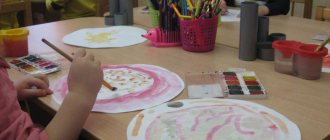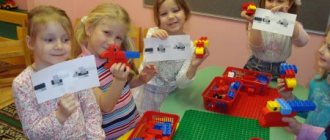The desire for independence and activity of children of middle preschool age allows not only to develop in them a sense of self-confidence when performing the simplest processes of self-service (dressing, undressing, washing, etc.), but also to include children in the simple household work of the family and kindergarten (table setting, washing toys and tea utensils, wiping dust, washing doll clothes and small children's things, etc.). The teacher’s task is to teach the child to carry out labor processes holistically (from setting a goal to obtaining a result and cleaning the workplace), to master rational methods of labor actions, to independently control the quality of the results of labor (is there any dirt left, is it wiped dry, etc.). It is the holistic mastery of the labor process and the ability to obtain results that enable the child to become an effective subject of labor activity within his power, to feel his skill, to assert himself, and to make him want to take on everyday work responsibilities, freeing adults from them (cleaning the play corner, serving in the dining room, etc. ). Mastering the position of a subject of child labor is the main pedagogical condition for a child to enter into real labor relations with loved ones. The introduction of duty, long-term work assignments, and collective work at this age is important for developing relationships with adults and peers, nurturing emotional responsiveness, empathy, conscientiousness, responsibility, camaraderie and other personal qualities.
Conceptualization, cognitive, speech, labor and gaming skills. In the course of one’s own labor activity, identify the goal, the subject of labor, labor actions, the result in self-service and household work, naming them correctly. Be able to establish consistency in specific processes of household labor.
Transfer ideas about the household work of adults to one’s own activities, performing feasible labor processes (table setting; washing dishes, paint cans; wiping off dust; washing doll clothes, small children’s things, etc.).
Show independence in self-care (the ability to use the toilet, wash thoroughly, use all cutlery, dress and undress; the ability to take care of one’s appearance, troubleshooting problems with a little help from an adult).
Master some special work skills: arrange cutlery correctly and symmetrically; pour enough water; lather; rub with a sponge (cloth), wiping away dirt; rinse; squeeze; rub fabric against fabric when washing, hang to dry, etc.
Reflect the processes of self-service and household labor in games on household themes.
Attitude to work. Experience the joy of participating in work and of helping an adult. Show conscientiousness, responsibility, activity, and initiative in work. Be confident in your abilities. Strive to help a friend, rejoice in his successes; treat the results of other people's work with care; respect the skill and independence of another person.
Levels of program development
Short. The child is not confident in himself; the desire for independence in self-care is not expressed. In household work, assistance is required with advice and instructions on preparing for work and performing work actions.
Average. The child is independent in self-care and takes care of his appearance without reminders. Help is required in household work; self-control is insufficient. The child clearly shows emotions about successes and failures at work, strives to learn, become skillful, and enter into real work relationships with loved ones. Willingly participates in collective forms of work activity, but performs the role of an assistant.
High. The child is independent in self-care, sets goals himself, sees the need to perform certain actions, and his work is effective. The child is distinguished by speed, accuracy, coordination of work actions, and self-control. Sometimes he acts as an organizer in collective forms of labor activity. Strives to fulfill work duties, willingly enters into real work relationships with adults and peers at home and in kindergarten, is capable of business cooperation, shows attention and care to children, and respect for elders.
Self-care for middle group children
Involving children in helping their peers is successful only if the former know in advance in what form this help can be provided and master these skills. If a child, for example, does not know how to fasten his own shoe, he will not be able to do it for another. Thus, the key to successfully connecting a child to help another is self-service. A child whose actions have been consolidated and whose skills have been developed, with great desire and interest, agrees to come to the aid of another. At the same time, practice shows that children, even having the skills of dressing and undressing, sometimes cannot apply the learned method of action in relation to their peers. Children begin to get lost, feel insecure, and turn to the teacher for help. This is explained by the fact that the guys were not taught how to transfer their skills to other conditions and situations. Therefore, the teacher’s task at first, when involving children in providing assistance, is to remind (and perhaps show and explain) what needs to be done and how. This instills in them confidence in their abilities and convinces them of their skills. Around the second half of the year, the teacher increasingly limits it to general reminders: “Do everything the way you do it for yourself, so that it is neat, correct, beautiful.” Systematic work on involving children in helping each other has a positive impact on the formation of the ability to come to the rescue without the constantly repeating demands of the teacher, independently. By the end of the fifth year of life, children not only strive to fulfill the adult’s task of helping someone, but also try to “teach” the person under their care how and what actions need to be performed. The form of assistance is becoming more advanced: in addition to direct practical actions, elements of training are increasingly appearing. When strengthening self-service skills in children, the teacher increasingly turns to their consciousness. He points out to children the permanent responsibilities in this type of work, explains why they need to be performed, and shows their importance to others. Sometimes in children by the age of 5 one can observe a decrease in interest in self-care work. This is caused by the simplicity and monotony of actions, frequent repetition of activities (dressing, putting away toys, eating, etc.), as well as the child’s insufficiently developed skills of independence, neatness and cleanliness at the previous stage. Therefore, it is necessary to interest them in the diversity of this work and create a certain emotional atmosphere. Thus, consolidating self-service skills, turning them into habits, and at the same time a condition for the formation of independence in everyday activities is maintaining interest in it. This is facilitated by the emotional experiences that the child experiences when undressing and dressing. That is why, at this age level, encouragement and objective assessment of his activities are so necessary. The emergence of a positive emotional state in self-service activities is also facilitated by the fact that the teacher brings to the consciousness of children what is good in their behavior, emphasizing the importance of independent activity for others and for the group of children as a whole. The teacher says: “Look how quickly Vanya and Sasha got dressed today. Sveta and Sonya helped them. Now let’s all play together.” Analysis of the results of work, their objective assessment becomes an effective method of raising children if the teacher strives to strengthen their desire to perform their duties better, faster, and on time. The adult gradually teaches the children to evaluate their own achievements in self-service and correct shortcomings on their own initiative. The whole atmosphere of life in a peer group helps to develop self-esteem in children of the average group. If one of the children has an incorrect attitude towards his duties (did not make the bed well, did not get dressed for a long time, and delayed the children for a music lesson), the teacher, together with his comrades, condemns him. As before, children in the middle group imitate their elders in performing self-care work, but they do it more consciously. The teacher becomes an authority for the children. They exactly repeat his actions, imitate even in small things. It is important that children feel in the tone of adults the obligation to fulfill their demands. At this age, you can already demand much more from children than from little ones.
Abstract on the topic Self-service in the middle group
Summary of lessons on organizing self-service for the middle group
Purpose: - to teach children to maintain order in the playroom, bedroom, locker room; promptly and immediately put each thing in its place, help adults and peers in cotton work.
-develop skills independently and with the help of adults and peers, maintain and restore order in the group
- to cultivate diligence, respect for working people: the ability and desire to value one’s own and other people’s work.
Equipment: household items and object pictures, Brownie toy.
Progress of the lesson
The day before, the teacher reads L. Voronkova’s story “Masha the Confused” to the children and conducts a conversation on its content:
-Who is the story about? Who woke up Masha in the d/s?
-Why was Masha late to the nursery one day?
</ -Почему она не смогла найти свои вещи сразу? Где лежали чулки? Где она нашла туфли? Куда было заброшено платье? Где она встретила детей в д/с? Кто виноват, что Маша опоздала?
Educator: -Who keeps order in the house?
- How do you help your mother with this?
-Who keeps order in the group?
-Do you help adults with this? How?
Children: we put toys away, hang clothes in a locker, put them on a high chair before going to bed, put shoes on a shelf, set the table, remove glasses from the table after eating.
Educator: Well done, everyone is attentive and helps maintain order in the group.
We will now go on a tour of the group and see if all the things are in place. If someone does not put the toy back in its place, then the toys may become offended and hide from you.
Teacher: approaches the sports corner and asks the children to name what is missing.
Children: skittles and ball.
Educator: approaches the music corner with the children and asks them to name what is missing?
Children: baskets with rattles
- in the arts and crafts corner - coloring books.
Educator: you see, the children hid a lot of things. But I’ll tell you who can help find them.
You know this hero. This is Brownie, he lives in every house and knows everything that happens in it. The teacher shows the children Brownie and pays attention to his appearance, and says that he is kind, attentive, caring and in his hands he has a bag in which there may be missing toys.
Brownie wants to play with you D/n.
"Wonderful bag"
The teacher calls one child at a time and asks them to take any item out of the bag. The child takes out the object, names it and takes it to its place. After the game, the teacher talks with the children:
-Why should every thing be in its place?
Children: so as not to waste time looking for it and you can take it right away.
Educator: who should keep order?
Children: adults and children.
Educator: you know where each of the things should be. But in every group and home there are many small items and they should also have their place. Brownie offers to play d/i “Every thing has its place”
There are a lot of small items on the table (sewing supplies, pencils, ribbons, hairpins, elastic bands, decorations for dolls) and (boxes, boxes, baskets, cups).
The teacher with the Little Brownie asks one of the called children to find a place for each item. After the game, Brownie rewards the children with stars for their help.






